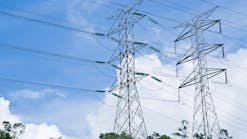What Does the Future Hold for Utilities?
The electric utility industry is in the middle of an unprecedented evolution. The transmission and distribution (T&D) grid, in particular, is experiencing notable changes because of the proliferation of distributed energy resources (DERs), the implementation of the smart grid concept and the realization of the electric power system as a key component of greater constructs. The latter includes the intricate interrelationships among electric power grids and other critical infrastructures such as oil, gas, water and telecommunications systems, as well as the emergence and growing interest in the smart city concept.
Regulatory mandates and economic incentives have prompted investments in critical T&D infrastructures as well as the adoption of advanced and emergent technologies to address challenges and societal concerns pertaining to these aspects. Among others, challenges include grid resiliency improvement and integration of renewable generation; societal concerns encompass improving the livability, workability and sustainability of cities. The evolution toward the utility and grid of the future requires solutions to address these challenges and take advantage of the associated opportunities.
Grid Resiliency
Because of the economic impacts of weather-related outages, particularly those caused by severe weather events like Superstorm Sandy, grid resiliency has received tremendous attention recently. It is estimated that the average annual cost of power outages caused by severe weather ranges between US$18 billion and $33 billion. Grid resiliency covers aspects such as T&D reliability, grid hardening, aging infrastructures, physical and cybersecurity, logistics planning and coordination, and workforce availability.
Grid reliability is vital in a digital economy to ensure competitiveness and efficiency. A 2012 survey on the subject places the U.S. behind other developed nations such as Germany and Japan in terms of System Average Interruption Duration Index (SAIDI). Although this comparison also should take into account important factors and root causes such as electricity prices — which is also an indication of end users’ willingness to pay for a specific reliability level — these results are indeed insightful and indicate a gap that needs to be addressed.
Grid hardening plays an important role to ensure resiliency and reliability. Solutions such as undergrounding, vegetation management, and higher design and construction standards, along with suitable advanced technologies and cost-recovery mechanisms are being revisited. Aging infrastructure also is a key issue. It is estimated that average electric power systems in the U.S. are 50 to 60 years old, and 25% of this infrastructure is at an age and situation where condition is a concern. According to the U.S. Department of Energy, 70% of transmission lines and transformers are 25 years or older, and 60% of circuit breakers are more than 30 years old. Industry analysts estimate that about 50% of distribution poles are 30 to 50 years old and near the end of their useful life.
Similarly, recent events affecting utility assets, such as Pacific Gas and Electric’s Metcalf substation attack, have highlighted the importance of ensuring the physical security of the electric grid. Along the same lines, the widespread and rapidly growing deployment of intelligent electronic devices to improve T&D grid visibility and awareness has drawn plenty of attention toward accompanying these investments with appropriate cybersecurity initiatives.
On the workforce side, forthcoming retirements represent a critical challenge, since it is estimated that about half of the utility workforce (including engineers and skilled workers) will be eligible to retire between 2014 and 2020. This represents a major talent gap in the utility industry.
DER Integration
According to the U.S. Energy Information Administration’s projections, non-hydro renewable sources are expected to grow 3.2% annually. Solar energy is expected to grow 7.5% annually to 2040. Thus, the need to integrate growing levels of variable renewable generation is expected to be addressed by a combination of infrastructure and technology initiatives. On the infrastructure side, for instance, the Federal Energy Regulatory Commission Order 1000 eliminated the right of first refusal or monopoly status for building transmission unless mandated by states. This is expected to lead to an increase in transmission development.
Technology trends include the consolidation of the smart grid concept; the deployment of phasor measurement units for the implementation of wide-area monitoring, protection, automation and control; and the convergence of operations and information technologies (OT/IT). This also includes the deployment of advanced metering infrastructures (AMI) and advanced distribution management systems (ADMS), the emergence of smart inverters, and the application of distributed energy storage and microgrids to improve system resiliency and facilitate the integration of distributed generation (DG) and plug-in electric vehicles.
Although still incipient, microgrids represent an exemplary grid-of-the-future solution because they use state-of-the-art technologies to address multiple objectives such as variable DG integration, resiliency, efficiency, reliability and power-quality improvement. It is estimated that the U.S. microgrid capacity may reach 1.8 GW by the end of 2017. There are currently 81 operational microgrids — including utility-owned deployments such as San Diego Gas & Electric’s Borrego Springs — and 35 under development.
System Planning and Operations
The infrastructure and technology trends are being accompanied by changes in the way power systems are planned, operated and analyzed. Proliferation of variable DG in T&D systems is making the grid more complex and dynamic. This creates an increasing need for grid analytics applications pertaining to modeling, analysis and planning, as well as better data gathering, processing, analysis and visualization functionalities. These applications should be able to handle the potentially massive amounts of data provided by smart grid technologies, with the purpose of extracting information that can be used in utility planning and operations activities in general.
Grid analytics is expected to be at the heart of OT/IT integration and play a key role in the operation of future power delivery systems, with advanced functionalities and applications residing at the core of ADMS, distributed energy resources management systems (DERMS), energy management systems and utility enterprise systems. The global utility grid analytics market is expected to grow to $3.8 billion annually by 2020, with U.S. utilities spending nearly $100 per home in grid operations and consumer-related analytics from 2013 to 2020.
Although remarkable progress has been made in these areas in the last decade, slower changes have occurred from a utility business standpoint. But this is starting to change, particularly among those electric utilities whose regulatory frameworks and business models made them vulnerable to threats posed by high penetration levels of DG. A survey conducted among 200 utility executives and professionals indicates that the increased interconnection of DG is the most significant challenge facing the utility industry over the next five years.
Photovoltaic (PV) DG, in particular, has experienced tremendous growth in the last decade. For instance, San Diego Gas & Electric has about 45,000 rooftop solar customers, and the adoption rate of this technology in its service territory is growing at a monthly rate of 4% to 5%. Moreover, high penetration of DG, particularly PV, is already a reality in utility systems such as Hawaiian Electric Co.’s system, where distribution circuits with more than 100% penetration (with respect to daytime minimum loads) are common. These trends are not exclusive to the Southwest anymore. In the U.S., the Northeast and Mid-Atlantic regions are also starting to experience proliferation of this technology.
A Death Spiral
Under perfect-storm conditions, DG proliferation could lead to a vicious cycle of decreasing electricity sales, customer grid defection, lost revenues and higher rates, commonly known as the utility death spiral. There is no consensus about the magnitude of the potential impacts of this cycle over the U.S. electric utility industry. However, there is agreement that electric utilities need to pay attention to the emergence of DG and grid-parity consequences. This includes assessing whether DG proliferation could represent a real threat to their business under their existing regulatory framework, potential DG adoption rates and related technology prices.
Prices of energy storage technologies, which are potential enablers of further proliferation of DG, have decreased steadily in the last decade. This trend could be accelerated by events like California’s legislation mandating installation of 1.3 GW of energy storage or Oncor’s intention to invest $5.2 billion in the deployment of 5 GW utility-owned battery energy storage systems.
It is worth noting that the potential threats from grid parity and grid defection are being acknowledged beyond the utility industry. For instance, in May 2014, Barclays downgraded the bond rating of the entire U.S. electric utility sector against the U.S. Corporate Bond Index. The driver behind this recommendation was the increasing opportunities from utility customers to reduce electricity consumption through PV and battery energy storage systems. This trend could “reconfigure the organization and regulation of the electric power business” in the next decade. Furthermore, publications such as Forbes and The Economist have dedicated ample coverage to this topic.
Therefore, utilities in general need to pay attention to the decreasing prices of DG as well as potential disruptive or transformational changes in technology and regulation. Although there is disagreement regarding when grid parity of DG technologies will be achieved, there is overall agreement about historical trends showing decreasing prices and growing research and development expenditures that may trigger the emergence of a disruptive solution.
PV prices have decreased steadily and rapidly in the last decade. If the trend continues or accelerates, and if there are regulatory changes incentivizing greater adoption, PV or other technologies can become an alternative for more end users. These utility customers may not disconnect from the grid completely, but they may use sufficient electricity generated and stored by their own PV and battery storage systems to decrease utility electricity sales and become an important threat.
Beyond Electricity Sales
The need for modern business models that address not only the aforementioned challenges associated with grid parity and customer grid defection, but also the business opportunities created by the proliferation of distributed grids and evolving customer expectations, requirements and consumption patterns, has prompted the emergence of proposals such as New York’s Reforming the Energy Vision (REV).
The REV proposal considers the introduction of regional distribution markets where DERs and “prosumers” — customers with the ability to produce and consume electricity — are expected to be able to conduct physical and financial transactions, and the establishment of market and grid operators, analogous to the independent system operator (ISO) concept used in bulk power systems. Evidently, this proposal to empower customers requires significant regulatory and policy changes, and also requires electric utilities to think seriously about their future role and strategy to provide value to end users.
Finally, the fundamental role electric power systems play in modern society and digital economies, and the complex interrelationships with other critical infrastructures, make it a vital component for the realization of the smart city concept. This paradigm calls for a holistic view of vital infrastructures and the integrated use of information and communications technologies to enhance the livability, workability and sustainability of modern cities.
The smart city framework implies an additional, likely complex, layer of integration and coordination with other service providers and further challenges beyond those discussed in this article. This also represents opportunities for electric utilities to improve efficiency through the use of information provided by others and to supply additional services and products beyond electricity sales.
New Portfolio
Addressing these trends and challenges, and taking advantage of the opportunities emerging from the transition toward the utility and grid of the future, requires a carefully coordinated and integrated portfolio of new and existing solutions that must encompass technology, infrastructure, regulation, policy and business aspects; one without the other will inevitably lead to unfeasible or unsustainable scenarios. It is important to highlight the acuteness of some of the issues previously discussed that will vary among different regions of the U.S. and different countries. However, they provide a good indication of emerging trends the industry is considering as well as those already shaping the utility and grid of the future.
Julio Romero Agüero ([email protected]) is senior director of distribution at Quanta Technology in Raleigh, North Carolina, U.S. He has worked with electric utilities and regulatory boards for more than 19 years. His areas of expertise are grid modernization, smart grid, technology strategy, planning, operations, analysis of power distribution systems, and integration of DERs. He is chair of the IEEE PES Distribution Subcommittee. He has authored more than 30 technical papers, and is a frequent speaker and instructor at industry conferences and training courses.
Mentioned in this article:
Hawaiian Electric Co. | www.heco.com
Oncor | www.oncor.com
Pacific Gas & Electric Co. | www.pge.com
San Diego Gas & Electric Co. | www.sdge.com






